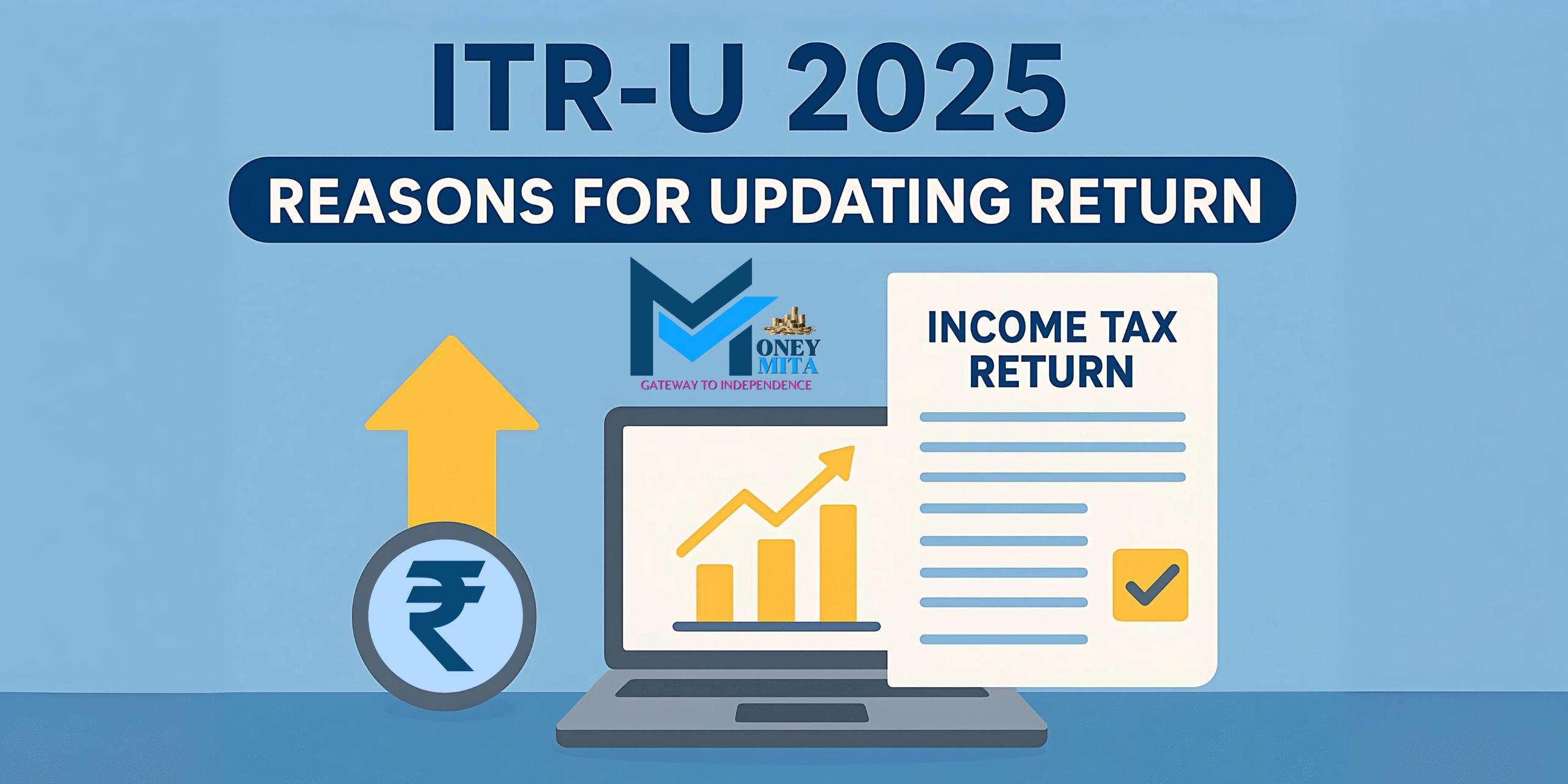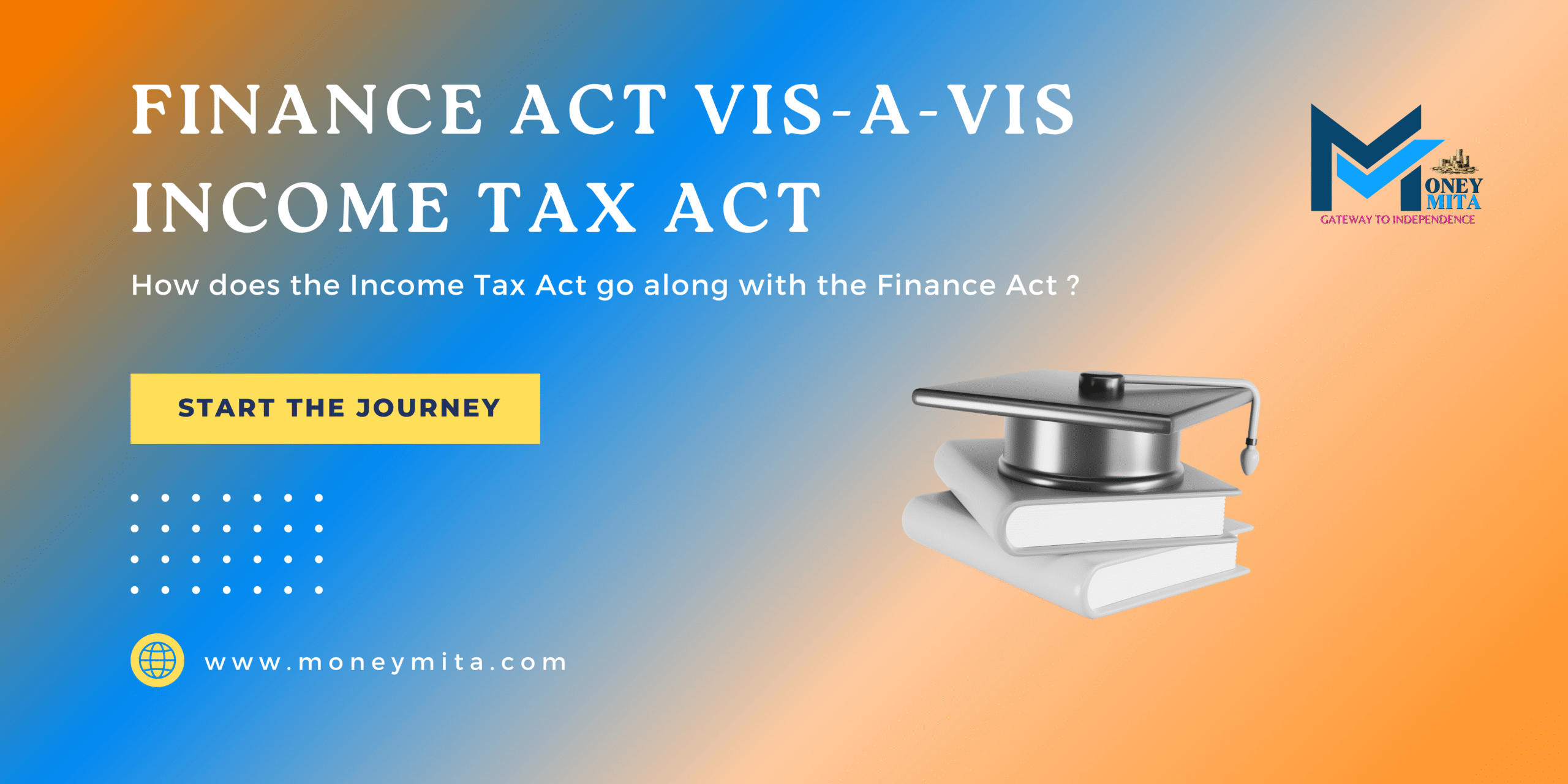ITR-U in 2025 (Income Tax Return – Updated) is a provision under Section 139(8A) read with Section 140B of the Income Tax Act that allows taxpayers to update or correct their income tax return even after missing the due date. Announced in the Union Budget 2022, this facility gives relief to individuals and businesses who failed to file their original or belated return, or who later discover omitted income, wrong calculations, or missed disclosures in earlier filings.
This blog will discuss reasons for filing an updated return in 2025.
Both original and belated income tax returns can be revised within the timelines allowed by law. However, if a taxpayer has not filed any return at all or wants to make corrections after the revision window has closed, the ITR-U filing option becomes the only remedy.
This facility is accompanied by defined eligibility conditions, time limits, and additional tax liability, making it a crucial tool for maintaining income tax compliance even after the usual deadlines.
Table of Contents
ToggleDifference: – Belated And Revised Return with Updated Return (ITR-U)
| PARTICULARS | BELATED RETURN | REVISED RETURN | UPDATED RETURN – ITR-U 2025 |
| 1. Who can file? | Any taxpayer who misses the original due date of filing the return (e.g., 31st July or 31st October). | Any taxpayer who has filed an original or belated return and wants to correct errors or omissions, is eligible. | Taxpayers who filed original, belated, or revised returns—or even those who did not file any return for an assessment year—can update their income under certain conditions. |
| 2. Time Limit | The standard window for belated returns is earlier of two dates: – 1) Before three (3) months from the end of the Assessment Year, i.e., up to 31st December of that Assessment Year (AY). 2) Before the completion of the assessment. | Same as belated return. | For filing an Updated Return (ITR-U), in 2025, the taxpayer has up to 48 months (4 years) from the end of the relevant Assessment Year. |
| 3. Tax Implications | Considered a valid return, but certain benefits (like carry-forward of some losses) may not be available. | Treated as a correction to the original/belated return. The revised version replaces the earlier return. | Treated as a new, additional return. Primarily used to avoid penalties or prosecution for income underreporting/concealment. |
| 4. Interest Liability | Yes – Interest levied under Sections 234A, 234B, and 234C for late filing and default in advance tax. | No interest is charged for late filing if the original return was submitted on time. However, interest under Sections 234B/234C for advance tax defaults, if any, still applies. | Yes – Interest levied under Sections 234A, 234B, and 234C till the date of submission of the updated returns. |
| 5. Late Fee | Late fees under Section 234F are applicable even when filing an ITR-U. | No late fee levied. | Late fees under Section 234F are applicable even when filing an ITR-U. |
| 6. Additional Tax | Not applicable. | Not applicable. | Yes – Additional tax of 25%, 50%, 60% or 70% (depending on the timing of filing ITR-U) over and above normal tax and interest. |
| 7. Effect On Assessment | Treated as a fresh but late return. | Replaces the earlier return (original or belated). The last revised return becomes final. | Independent filing; does not replace earlier returns but adds to the record with updated disclosures. |
| 8. Applicable provisions in the Income Tax Act | Section 139(4) | Section 139(5) | Section 139(8A) |
Reasons For Filing an Updated Return (ITR-U 2025)
The Income Tax Act specifies situations requiring an Updated Return [ITR-U under Section 139(8A)]. There are eight (8) major reasons a taxpayer may need to file it.
- Return Previously Not Filed
- Income Not Disclosed Correctly
- Incorrect head of Income chosen
- Reduction of Carry Forward Loss
- Reduction of Unabsorbed Depreciation
- Reduction of Tax Credit u/s 115JB Or 115JC [MAT / AMT]
- Wrong Rate of Tax Applied
- Others [Miscellaneous Reasons]
Let’s discuss one by one.
1. Return Previously Not Filed: –
If a person misses both the original return due date and the belated return deadline, the only option left is to file an Updated Return.
Example:
Rajesh (Resident Indian, age 40) earned ₹8 lakh in FY 2023–24 [AY 2024-25] from consultancy but failed to file his return by 31st July 2024 (due date) or even by 31st December 2024 (belated return).
👉 His only remedy is to file an ITR-U under Section 139(8A) within 48 months from the end of AY.
👉Last date to update = 31st March 2029.
2. Income Not Disclosed Correctly: –
Sometimes, income is inadvertently missed, and the error is discovered after the revised/belated return window closes.
Example:
Priya, 30, a salaried employee, filed her return for FY 2023–24 reporting ₹6 lakh as income. Later, she realised she forgot to report a bonus of ₹1 lakh.
👉 She must file an Updated Return showing the total income of ₹7 lakh and pay the differential tax.
3. Incorrect head of Income chosen: –
Incomes must be reported under the correct head (Salary, House Property, Business/Profession, Capital Gains, Other Sources). Wrong classification impacts tax liability.
Example:
Speculative trading income of ₹2 lakh was wrongly shown under Capital Gains instead of Business Income.
👉 Must be corrected via ITR-U to reflect the right tax treatment.
4. Reduction of Carry Forward Loss: –
Excess claim of carry forward business losses lowers tax liability wrongly. The updated return ensures correct computation.
Example:
A company claimed a carry-forward loss of ₹50 lakh under Section 72, but the audit confirmed only ₹40 lakh was eligible.
👉 ITR-U must be filed to reduce the claim by ₹10 lakh.
5. Reduction of Unabsorbed Depreciation: –
As per Section 32(2), unabsorbed depreciation can be carried forward indefinitely. However, a wrong calculation may inflate the claim.
Example:
ABC Ltd. claimed ₹15 lakh as unabsorbed depreciation, but on reassessment, only ₹12 lakh was allowable.
👉 The company must file an updated return, reducing the excess₹3 lakh.
6. Reduction of Tax Credit u/s 115JB Or 115JC [MAT / AMT]: –
Excess credit claimed under Minimum Alternate Tax (MAT) or Alternate Minimum Tax (AMT) must be corrected through ITR-U.
Example:
XYZ Pvt. Ltd. claimed MAT credit of ₹5 lakh. The review revealed that only ₹3 lakh is eligible.
👉Updated return required to reduce the excess ₹2 lakh credit.
7. Wrong Rate of Tax Applied: –
Applying incorrect tax slab rates or wrongly availing senior citizen benefits can reduce tax liability incorrectly.
Example:
Arjun (age 53, resident, not a senior citizen) declared an income of ₹10 lakh but wrongly claimed a senior citizen exemption of ₹3 lakh instead of ₹2.50 lakh.
👉 ITR-U is needed to correct the computation and pay any additional tax due.
8. Others [Miscellaneous Reasons]: –
Any other errors or omissions not covered above.
Examples:
a) Excess deduction claimed: Shreya claimed ₹60,000/- LIC premium under Section 80C, but only ₹40,000/- was eligible.
👉Excess claim of ₹20,000/- must be corrected.
b) TDS mismatch: If the employer reports wrong TDS, it may lead to under/over reporting of tax credit.
👉 Can be rectified using an Updated Return (only when it results in additional tax payable.
Time Limit To File An Updated Return (ITR-U 2025)
🚀Kickstart Year
Finance Act 2022 introduced Section 139(8A), permitting taxpayers to file an ITR-U -Updated Return within 24 months (2 years) from the end of the relevant AY.
Subsequently, Rule 12AC [via CBDT Notification 48/2022, dated April 29, 2022] defined Form ITR-U and applied it from AY 2020–21 onwards. This means that although the provision started for FY 2022–23 (AY 2023–24), it also applies retrospectively from AY 2020–21.
SOURCE: –CBDT NOTIFICATION 48/2022
Example under the old 24-month rule:
If you missed reporting income in FY 2019–20 (AY 2020–21), the AY ended on 31 March 2021. Under the old rule, you had 24 months from that date, i.e., until 31 March 2023, to file an ITR-U.
⌚New Time Limit (Finance Bill 2025)
📌From April 1, 2025, the filing window is extended to 48 months (4 years) from the end of the relevant AY, vide CBDT Notification 49/2025 dated May 19, 2025.
SOURCE: – CBDT NOTIFICATION 49/2025
Example – New 48-Month Rule:
For AY 2023–24 (FY 2022–23), the AY ends on 31 March 2024. With the new rule, you can file an updated return until 31 March 2028.
Due Dates for ITR-U Filing (Last Six Years)
| FINANCIAL YEAR – FY | ASSESSMENT YEAR – AY | LAST DAY OF AY | LAST DATE TO FILE ITR-U |
| 2019 – 2020 | 2020 – 2021 | MARCH 31, 2021 | MARCH 31, 2025 |
| 2020 – 2021 | 2021 – 2022 | MARCH 31, 2022 | MARCH 31, 2026 |
| 2021 – 2022 | 2022 – 2023 | MARCH 31, 2023 | MARCH 31, 2027 |
| 2022 – 2023 | 2023 – 2024 | MARCH 31, 2024 | MARCH 31, 2028 |
| 2023 – 2024 | 2024 – 2025 | MARCH 31, 2025 | MARCH 31, 2029 |
| 2024 – 2025 | 2025 – 2026 | MARCH 31, 2026 | MARCH 31, 2030 |
In the current Financial Year 2025-26, updated returns for AYs 2021-22, 2022-23, 2023-24 and 2024-25 can be filed.
Does Additional Tax Need to Be Paid Before Filing an Updated Return?
Yes, ———— When filing an Updated Return (ITR-U), any additional tax due must be paid, and the amount depends on the filing date. Let’s break down how this works.
It is a three (3) -steps process of calculation.
- The First step is to calculate the Aggregate Tax.
- The Second step is to calculate the Additional Tax.
- The Third and Final step is to obtain TOTAL TAX PAYABLE – WHILE AN UPDATED RETURN IS FILED.
STEP – 1
Computation Of Aggregate Tax Payable on the Updated Return [Section 139(8A)]
Before submitting the updated return, the taxpayer must deposit the tax calculated as per the revised return. The computation is:
1. Tax as per Updated Return (including education and Higher education cess) (revised computation) = A (say)
2. Less: Taxes already paid [SL No – i) to v)] by any means of the following:-
i) Advance Tax already paid = B (say)
ii) TDS/TCS already deducted = C (say)
iii) Relief [Under section 89, 90, 90A and 91)] = D (say)
iv) Tax credit [Under section 115JAA and 115JD] = E (say)
v) Self – Assessment Tax [Under section 140A(1)] = F (say)
TOTAL TAXES PAID: – [SUM FROM B➡️F] = (B+C+D+E+F]
3. Balance Taxes to be paid [SL No. 1-2] = G (say)
4. Add: Net Interest paid [under section 234A, 234B and 234C]
i) At the time of furnishing the updated return =H (say)
ii)Less: If paid earlier = I (say)
NET INTEREST TO BE PAID 👉 [SL No. 4(i-ii)] = J (say)
5. Add: Late Fee Paid [ under section 234F] = K (say)
6. AGGREGATE TAX PAYABLE [SL No. (3+4+5) ] = L (say)
STEP – 2
Computation of Additional Income Tax (AIX) Payable under section 140B On the Updated Return [Section 139(8A)]
The additional tax (penalty) depends on how quickly the updated return is filed within the 4-year window. The longer you wait, the higher the penalty:
| Filing Timeline [From the end of the relevant Assessment year (AY)] of ITR-U | Additional Tax (AIX) [Specific “%” for filing timeline of “L -In STEP -1”] |
| Within 12 months (<12 months) | 25% of tax & interest payable (25% of L – as per STEP – 1) |
| 12–24 months (≥12 but <24 months) | 50% of tax & interest payable (50% of L – as per STEP – 1) |
| 24–36 months (≥24 but <36 months) | 60% of tax & interest payable (60% of L – as per STEP – 1) |
| 36–48 months (≥36 but ≤48 months) | 70% of tax & interest payable (70% of L – as per STEP – 1) |
STEP – 3
Computation of Total Income Tax Payable While Filing an Updated Return [Section 139(8A)]
Let’s say total tax payable = TTP
Now TTP = Aggregate Tax from Step-1 + Additional Tax from Step-2 = (L+AIX)
It means, TTP = (L+AIX): – Which is nothing but “SUMMATION OF AGGREGATE AND ADDITIONAL TAX PAYABLE ON THE UPDATED RETURN“.
⚠️ Key Insight: While the Updated Return offers a chance to correct errors, the penalties increase progressively—up to 70% of the additional tax if corrections are delayed until the fourth year. Filing earlier can save significant costs.
Frequently Asked Questions (FAQ)
Q1. Is filing ITR-U mandatory if I discover an error?
Ans. Not mandatory but recommended to avoid penalties and notices.
Q2. My update leads to zero additional tax—can I still file ITR-U?
Ans. No. ITR-U is meant for cases where additional tax (plus applicable interest/fees) is payable. If your update reduces tax or results in a refund, you are ineligible to file an updated return
Q3. Can I set off brought-forward losses while filing ITR-U?
Ans. Only as allowed by law, and provided the updated return does not create or increase a refund, or reduce overall tax. Any reduction in carry-forward losses must be reflected in subsequent AYs too.
Q4. Does receiving a notice under Section 148A affect ITR-U eligibility?
Ans. Yes. If a show-cause under section148A is issued after 36 months from the end of the AY, ITR-U is barred—unless the Section 148A (3) order states it’s not a fit case.
Q5. If I file ITR-U, am I safe from penalty or prosecution?
Ans. ITR-U is a voluntary-compliance route, not blanket immunity. Penalties or prosecution may still apply in cases like search/survey, specified Acts violations, or foreign asset reporting.
Q6. How do I compute the time window—Assessment Year vs Financial Year?
Ans. Start from the end of the Assessment Year (not FY). Example: FY 2022-23 → AY 2023-24 → month-count begins from April 1, 2024, for the 12/24/36/48-month windows.
Q7. What is the “Additional Tax” under Section 140B?
Ans. It’s calculated on the total of tax + surcharge + cess + interest + late fees due to the update. Additional tax rates: 25% (within 12 months) or 50% (after 12 but within 24 months) etc.
Q8. What is MAT?
Ans. Minimum Alternate Tax (MAT) ensures companies pay a minimum tax even if exemptions/deductions reduce normal tax liability. Applicable under Section 115JB.
Q9. What is AMT?
Ans. The Alternate Minimum Tax (AMT) ensures non-corporate taxpayers (like firms, LLPs, or individuals claiming exemptions) pay a minimum tax. Applicable under Section 115JC.
Key Difference: MAT = for companies; AMT = for non-corporates.
Concluding Note: -Once you know the Reasons For updating the Return, the next step is understanding how to e-file an updated return with proper verification.
Read the 3rd Blog: “ITR-U 2025: E-FILING AND VERIFICATION GUIDE”

I am a practicing Chartered Accountant, now venturing into content writing. Covering money matters—taxation, finance & financial news—presenting accurate, easy-to-understand insights, combining professional knowledge with a passion for educating readers on managing and understanding their finances better.








